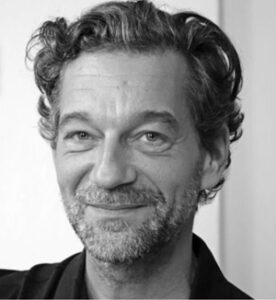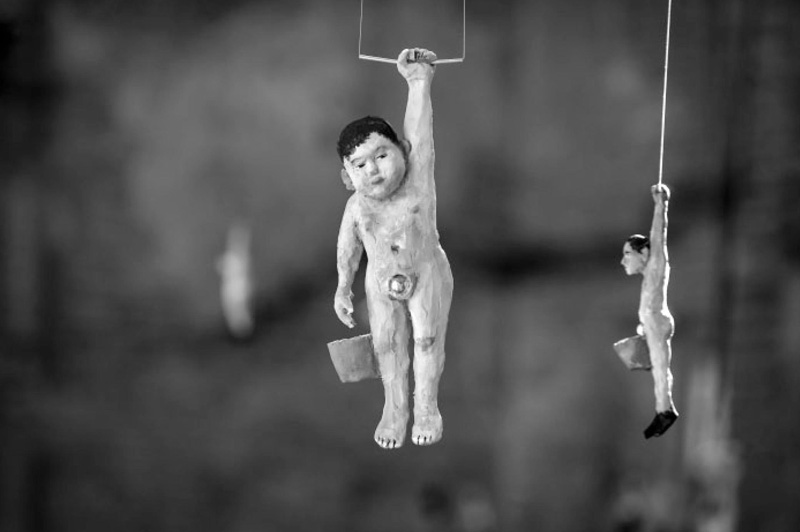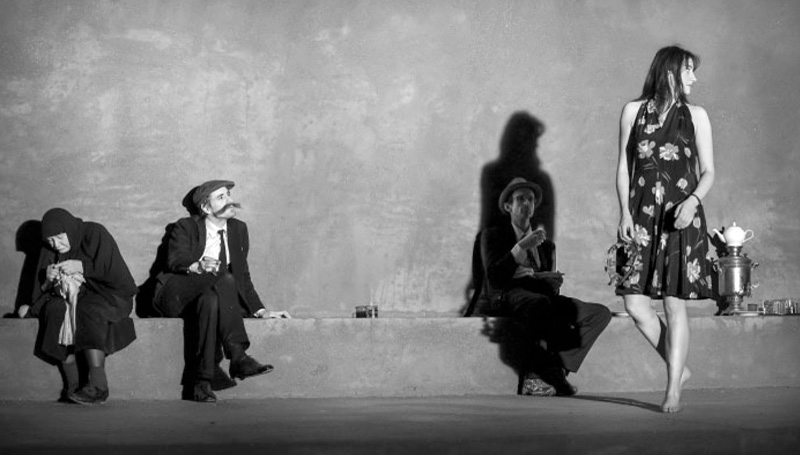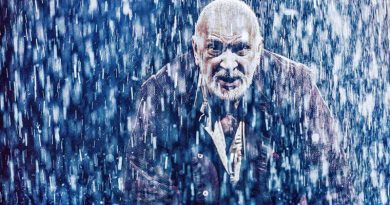Iko Freese photography interview: Dana Rufolo
The Unpredictable and Unrepeatable Image: Iko Freese, Berlin theatre photographer
Interviewed by Dana Rufolo
3 December 2018

Photo credit: Axel Hörhager.
Iko Freese calls himself “obsessed” by photography. For him, the ideal photograph is a work of art and not just an infinitely reproducible image of so-so quality. He fell in love with photography when a child playing around in his uncle’s old-style studio.
Freese continues to champion his ideas about photography as an art form that startles by its originality, but he has also adjusted himself to the reality of market demand. Besides creating the photographs of major Berlin theatre productions during a period of over twenty years and even currently – although nowadays he has specialized more in opera photography – he manages an ever-expanding theatre photography agency that presently stocks over one million digital pictures covering the past 50 years of Berlin theatre history.
I see that although you have specialized in theatre photography for decades, you now frequently photograph operas. In fact, you’ve been working right now [at time of interview – winter 2018] on photographing Erich Wolfgang Korngold’s “Die tote Stadt” (“The Dead City”) which opened at the Komische Oper Berlin in October.
I started taking portraits; then I changed to theatre photography and got quite obsessed with it. I am freelance now, but also had an appointment as a full-time house photographer at the Deutsches Theater Berlin from 2001 until 2009.That was a very interesting and successful period in my life, but it was also a hard time. And now, finally, I am in opera, so yes.
Why was it a hard time? Because of the people you worked for or the nature of the work you did?
Well, they had all these soon to become legendary directors there then: Jürgen Gosch, Dimiter Gotscheff, Robert Wilson, Peter Zadek, Hans Neuenfels – Michael Thalheimer had just got started. They had the big stage (Grosses Haus, 600 seats) and the big names. They also ran a Chamber Theatre (Kammerspiele, 230 seats), and invented a new tiny stage, called Box and Bar (99 seats). So, in fact there were about five premieres a month. This was hard because it was quite exhausting to photograph all of them. Okay, it was well paid, and I got a large budget for material and even had assistants.

Deutsches Theater Berlin. “Anatomy Titus Fall of Rome: a Shakespeare
Commentary” by Heiner Müller. Director Dimiter Gotscheff, set designer
Mark Lammert, premiere November 28, 2007. Scene with Wolfram Koch
and Sebastian Blomberg.
Were you photographing using film or was it digital?
It was film and then we changed to digital in 2005, 2006.
You were doing all the photography for five premieres a month?
Exactly, I photographed nearly all the relevant rehearsals. I started at the rehearsal called “AMA – Alles Mit Allem”. It means “everybody with everything”. It is the first time you are able to watch the show in the real set with the real costumes, the real make-up – wigs, all that stuff, and they are trying to do a complete run-through, no stops for notes … a dress rehearsal, but earlier on in their preparations. Then I photographed two or three of what are called “main” rehearsals, and then there also was the general. The dress rehearsal was one week in advance; then we had two or three main rehearsals, a break for one night, and then the general.
And each of these rehearsals needed photographing?
Yes, as they were still improving and fixing …
You would first do the “Alles Mit Allem” and then all these other rehearsals? Well, you are more meticulous than the British – after the dress rehearsal they go into the previews.
I know. Unfortunately, there are no previews in German theatre.
There is no audience at the general rehearsals?
Nowadays, since three or four years, they are selling tickets for the generals.
With all these rehearsals being photographed, how many photographs were you producing for each show?
Perhaps 50 or 60?

Zeitgenoessische Oper Berlin. “Ton, Scene for Mobile, Audience
and Instrumentalists” by Sabrina Hölzer, Liza Lim and Volker
März, director Sabrina Hölzer, music Liza Lim and Elision Ensemble,
set designer Volker März, premiere on March 15, 2008 at the
Elisabethkirche Berlin. In this piece, the draught created by brass
instruments made mobiles such as these sway.
You mean, you showed the press department 50 or 60, but you were taking a lot more?
You bet! I can’t remember how I stayed alive with the workload, and also think about the psychological part of it. It’s all going well, as long as nobody is sick or having great difficulties. But if they do? Just imagine the atmosphere …
So out of those five premieres a month, one or two would be fraught with difficulties due to illness or such?
More like two or three. And you always can blame the photographer when something doesn’t look right, much better than commenting on the main actress, the tenor, or somebody like that. I give you an example from right now, from “Die tote Stadt”. We needed pictures for the programme from the “Klavier Hauptprobe (KHP)”; in opera it’s equivalent to a dress rehearsal. On Monday they built up the set and had a rehearsal in the evening. They started lighting on Tuesday, continued on Wednesday, and on Thursday afternoon was the KHP. Well, on Wednesday actually, the soprano, the main singer, broke her middle toe. Around the KHP everybody is always extremely nervous, but the show was going quite well until the soprano appeared on stage wearing white sneakers to protect her toe. She hadn’t warned anybody in advance. But seriously – you can’t have a gorgeous soprano wearing white sneakers in a programme book. Then there also were a few problems with her wig, not to mention the lighting, which was not finished at all. So, there was sweat and tears and everything. The rehearsal finished at ten, but it took me until four thirty in the morning to find an acceptable picture without the white sneakers …
How did you start photographing?
I started as a child. I grew up in East Frisia on the North Sea, but in my mother’s family in Kiel there was a very old photo studio. It was a portrait atelier that had belonged to the family for almost a century and then was run by my Uncle Walter. As a child I loved it. I must have been four or five years old. The dark room, the red light, the smell of the chemicals. My uncle was still alive; he had such a head and white hair and unbelievably nice eyes. He had this large camera. I think the negatives were about 9/12 inches. He didn’t use an enlarger for the prints, he just took the negative, turned the paper under it, exposed it, and that was it – a one-to-one copy. So, the quality was amazing, all the details … And I loved all those technical things, the cameras, the clicking, this mysterious going under the fabric to shoot. When I was 14 or 15 years old, I spent all my money on cameras and enlargers. Within ten minutes, I could change my bedroom into a complete darkroom.
Did you then study photography professionally?
After I got my “Abitur” (graduation from an academic high school), my parents made it very clear that I was allowed to do anything as long as it had nothing to do with photography. So, I studied psychology – I’m actually a psychologist. But during my studies I secretly started to take photos again. When I then moved to Berlin for different reasons, I was about 26, I needed money to pay the rent, and so I started my career as a professional. This time I could change the storage room of my apartment within five minutes into a darkroom, and my living room in fact was a studio. I started to take portraits of people, like Uncle Walter had done.

Komische Oper Berlin. “The Monteverdi Trilogy – Orpheus, opera with music” by
Claudio Monteverdi edited by Elena Kats-Chernin and a libretto by Alessandro
Striggio the Younger, conducted by Andre de Ridder, directed by Barrie Kosky,
stage/costumes Katrin Lea Tag, costume design Katharina Tasch, opening
September 16, 2012. Dancer Nikos Fragkou carries Julia Novikova as Eurydice
with Dominik Köninger as Orpheus, extreme right.
You were not crawling under cloth any more of course. You were using a Leica?
How did you know that?
Because every theatre photographer I’ve interviewed was using a Leica at the start of their careers. Which one did you use?
The ‘R’ series, not the little ‘M’ one. I had something like eight different Leicas …
Who came to you?
I was asking people I saw on the street who looked somehow interesting to me. Old people, young people, sexy people, ugly people. My interest was pretty much unpredictable, so were the photos. I did a lot of work with tramps. They didn’t pay me, naturally; these were my own private projects. But there were others who paid. Actors who needed pictures for their portfolios.
Did they know you might use the photos of them later on?
I never did. I hate my personal work being displayed.
You don’t have shows?
I do now if I’m forced to. But it’s always so much bother and feels like giving away a piece of myself. I really love to take a proper photograph and then I want to get a very nice print out of it. Then I write a little number on it with a pencil, put it into a drawer, and keep it there. It’s quite a contradiction, I know, because I do a lot of work for press departments. I think there aren’t many websites related to theatre in Berlin without a picture that I’ve taken. I so much hate it. I never think of the photo being published the second I press the button. Even though my work has been in just about every international newspaper or magazine I always was interested only in the person or the subject and in getting a very accurate picture.
But there is the “Deutsches Theater” book that includes hundreds of your photos. (This is a reference to the book “Deutsches Theater Berlin 2001 -2008. 2 Bde. Band I: 150 Inszenierungen in Bildern. Band II: Chronik.” Berlin: Henschel Verlag, 2008.)
Well, that was more like a summary with more than a thousand pictures indeed. The theatre wanted to do it, and eventually I enjoyed working on it very much. But I wasn’t thinking about the book being available on Amazon – I was thinking about offering a serious documentation.
You are not interested in distributing your own work then? But of course, with today’s digital methods there is very little that is private about any of us. Actually, it is quite serious because people begin to think that they only are what they put on Facebook about themselves. It makes us all shallow. So, you’re trying to not be shallow?
Well, as I grew up on the North Sea, shallow water is obviously not my thing! You know, today many people even don’t think of photographs as being a piece of work of somebody else anymore.
In Britain the press departments distribute the photographs they have purchased to advertise the show to whomever they want. It has to have your copyright name on it, of course, and they can’t use the photos for other than promotional purposes for the show. Is that the same here in Germany?
Yes, it is similar – lucky me! German theatres or opera houses mostly can’t afford a complete buy-out. The German copyright laws allow the copyright holder to even regulate single rights – I might offer 20 pictures and you may use them for promoting for your show. But German copyright laws also allow a strict limitation of use. For instance, only for German-speaking countries. Or I can limit the use to only five years or ten, whatever. And that’s exactly what is in my contracts – no other rights are included. So, for example, if you want to use my pictures for a schoolbook, you’ll have to buy them from me.
Let me get this straight. You were under contract at the Deutsches Theater as a full-time house photographer …
…and if you today want to insert my photos (their photos…) into a schoolbook, you have to ring me. Again: lucky me.
But I got it; you are still interested in my past, so from 2001 until 2009 I had the contract with the Deutsches Theater. Then suddenly Jürgen Gosch died of cancer. At that time, he was the most relevant director for me. He was unique, very much experienced, and I truly loved and admired his work which was at that stage nothing but unbelievable. He created a way of doing theatre, of directing the actors that I’d not seen before … and, frankly, I’ve never seen it after. The actors and the situation got real on stage.

Director Jürgen Gosch with his assistant Sabine Auf der Heyde during
a rehearsal on April 27, 2009 for his last show, “Idomeneus”, which
premiered at the Deutsches Theater Berlin on April 28, 2009.
How did they become real on stage? You mean he used the Stanislavsky method?
I’m not sure if German actors can do method acting at all. He made them believable and intense by getting familiar with all his actors and actresses; it was a very closed and exclusive circle, and it was very clear what we all were working on.
Did he have extra-long rehearsal periods?
Yes, his technique required much more time than the usual six weeks of rehearsing. And during the day sometimes a rehearsal would start at ten in the morning and ended at eleven at night. My last picture I’ve taken of him is him lying on a bed in the middle of the stalls of the Deutsches Theater directing his last show. He didn’t even see the premiere. He was a maniac. But that’s what it’s all about, isn’t it? It’s The Hotel New Hampshire again as Coach Bob says: “You have to get obsessed and stay obsessed, and always keep passing the open windows”. You can’t do any kind of work in theatre or opera without staying obsessed. It just doesn’t work.
So when Gosch passed, for you it was the end of an era?
Yes, it definitely was and it also was the end of theatre for me. I stopped going there; it’s been nearly ten years now. I just couldn’t stand it any longer. Happily, I met Barrie Kosky, who now is running the Komische Oper Berlin, a few years in advance. When Barrie told me about his plans to reopen the Komische Oper in 2012 with doing all three Monteverdi operas on one day, I immediately felt like wanting to be a part of it. And since that Monteverdi marathon I’m doing three or four shows there every season, and that’s enough for me. I also work for a handful of other houses, which I also do love, but the Komische Oper feels like home for me.
What other professional engagements have you had in your career as a theatre photographer?
Well, plenty, and there also was the business with the agency. In the early 2000s in Germany we had a media rush – now we have a media crisis, as everybody knows. But in the late 1990s and early 2000s, prompted by the “Wiedervereinigung” (German national unity) every big newspaper moved at least a small department to Berlin, the new capital: the “Süddeutsche Zeitung” gave one full page to cover things happening in the city, it was called the “Berlin Seite” (“Berlin” page). “The Frankfurter Allgemeine Zeitung” (“FAZ“) made up a completely new section, called the “Berliner Seiten”. And I started working with them, so they printed about four, five pictures a day. My second job was working for “Der Spiegel” magazine, and for both of them I only did theatre. Can you imagine that? Theatre only? From today’s perspective it seems impossible; they flew me in wherever there was a show to be photographed.
You went to London as well?
They weren’t that much interested in what they considered to be foreign culture then. But I travelled all over Germany, Austria – Vienna, Bayreuth of course. It was very well paid, and I was young and travelling a lot. It was cool, I loved it. Now I hate travelling, I absolutely do. Carrying all the equipment and the heavy bags. It’s nothing but a mess.
You were mentioning the agency …
Yes, the agency. In the week before a production premieres, the theatres offer one of the rehearsals to freelance photographers to take pictures of the show. They do this in many German cities. These photo-calls are meant to avoid a major discussion concerning treating journalists and photojournalists the same way, as of course the theatres invite journalists to their premieres. Therefore, they offer one of the main rehearsals, to avoid the distraction of clicking going on during the premiere. In the early 2000s I went to, let’s say, a photo-call at a state theatre. I sold freelance photos to several newspapers and was also always attached to Der Spiegel. But I had in mind to find an additional distribution for the remaining photos. The idea of running a photo agency of my own seemed a very good idea. So, I started working together with other photographers who have been supporting me a lot. And I started collecting photos. I established an agency called DRAMA. Agentur für Theaterfotografie (DRAMA. Theatre photography agency).
You started buying out peoples’ collections?
Yep. My main point of interest is Berlin. Theatre, opera, ballet and dance. We started to go backwards, and now we cover nearly 50 years of Berlin theatre history. So, if you want to do any publication related to performing arts it’s very likely that you’d be working with us. Which I like very much. This kind of work is intriguing. For example, DRAMA may be asked to choose pictures for, let’s say, a schoolbook that is intended to teach pupils about Brecht.
What are the criteria you are using when you choose a photograph?
At first, it’s all about quality and I obviously have to like the photo. Which means it has to have something disturbing in it, something not quite what you expect. Of course, my choice for schoolbooks depends on other things. There are directors I like better, stages I prefer, and in some sense, it is a kind of promotion. You really do not have to promote the Staatsoper Berlin (Berlin State Opera), but you can always try to promote the interesting ideas and concepts of the less well-known theatres and unknown directors who aren’t in the spotlight yet – unknown but who have a knack for developing novel images and new ideas.
So you try to spread the fame?
Yep.
Let’s conclude by you telling our readers something about your upcoming task of photographing at the General Rehearsal of “Die tote Stadt” to get the photographs that the Komische Oper is going to use for the press department and to otherwise advertise the show.
Well, at the General they are streaming the premiere live. ARTE is going to film it, and it goes to OperaVision where it is streamed online. But the producers don’t want to rely on just filming the premiere. They are shooting in advance, so as to have material in reserve.
In other words, you’re going to be there, and ARTE is going to be there (ARTE, Association relative à la télévision européenne, is a public television network that is Franco-German, promotes culture and the arts, and is co-funded by the European Union) at the same time?
And also several freelance photographers, so it might get a bit crowded; the Komische Oper is a fancy house, so they draw a lot of them.
ARTE will bring five or six cameras. I won’t be able to move a single centimetre, so I have to be very sure about my position. And remember I at least still need a proper photo of the soprano. They’re inventing something for her to wear on her feet: red pumps with a special support, or something like that.
What cameras will you be using?
I’ll be using one camera only, because I really try to minimize my equipment. So I’ll only bring a digital Canon monster.
“Monster?” Are you referring to a problem with digital?
Well, somehow. Leica invented the small camera system in the 1920s, and it took the industry until 1990 to provide a proper colour negative film; we’re talking about nearly a lifetime. So how could it be possible to engineer a proper digital technique within seven or eight years’ time? We’ve gotten used to the digital image and think it is a proper picture, but it definitely isn’t. The colours still are not true; skin appears like wax, contrast always is lacking or exaggerated, and even the black and white tone scales are completely wrong. The whole industry pretends to be selling real cameras, but unfortunately they are not. And Adobe is making a fortune out of it. Well, I like working with Photoshop – but the magic is all gone. Watch the teenagers today who have never seen a real photograph in their life.
People show you something on their smartphone and think that’s a picture. But it actually is something completely different. It’s a file with a resolution of about 140 kilobytes, and they don’t understand the difference. It’s not a photo. It’s something, but it’s not a photo. Now each and every one of us becomes used to this kind of very bad quality, and Apple in fact is selling the iPhone advertising this nonsense. That’s okay for me, but it definitely has nothing in common with Uncle Walter’s 9/12 inches black and white negatives that he was copying one to one.
I suppose you don’t think about retirement?
I love my work. I feel responsible for the things I do, and also for my team. Without them I couldn’t do it anymore. And – as long as we earn enough money …
Do you need to take care of your own retirement pension?
In Germany there has been a very nice invention. Once you work in a theatre house, opera or ballet, you automatically become a member of the Bayerische Versorgungskammer. They offer their insurance only for those who work for a stage and – for chimney sweeps. All the lucky ones obviously. And even if you quit the theatre before retirement age, you can continue paying in and you will get an adequate pension.
This interview was conducted in English.






